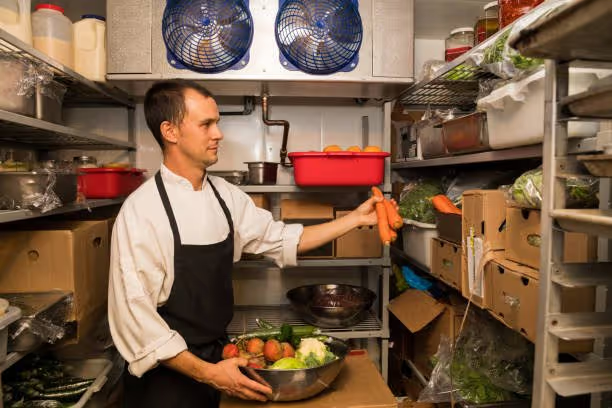Is your refrigerator running? Then you better make sure it’s the best fit for your kitchen! 😉
All jokes aside, commercial refrigeration is the backbone of any restaurant. Having the consistent ability to keep food & beverage products at the right temperature is key in running a successful business. Ensuring your commercial kitchen refrigerator is running optimally & is the best fit for your space will eliminate any risk of contaminated food, sick guests, or health code violations. Thats why when it comes to restaurant equipment, it is very important to select the right commercial kitchen refrigerator for your business.
We’ve been in the restaurant game for a while now, so we get it - commercial refrigerators are expensive. That’s why we’ve put together this comprehensive & easy to understand guide on how to make the best purchase possible. If you’re looking to buy a commercial kitchen refrigerator or refrigeration system, you’ve come to the right place!
Buying Guide: Commercial Kitchen Refrigerators
What we’ll cover in this guide:
- Things to consider when buying a commercial refrigerator
- Types of commercial refrigerators
- How To Cut Costs & Increase Longevity of Commercial Refrigerators
Keep reading to learn more about commercial refrigeration for your kitchen!

1) Things to consider when buying a commercial refrigerator:
- Function
The first thing to consider when purchasing a new commercial refrigerator to for your kitchen is the purpose and need behind the buy. Ask yourself these questions:
- Are we replacing an existing refrigerator?
- Is this a long-term investment?
- How critical is this purchase compared to other upcoming equipment needs?
- Will this fridge be stationary or need to be moved at all?
There are many different types & purposes of commercial fridges, so identifying the ‘why’ behind the purchase will help you make a smart buying decision
Common functions or purposes for restaurant refrigeration includes: Walk-In, Bar, Under Counter, Food Display, and more!
- Capacity
What is the size needed for your refrigerator? Depending on the size of your restaurant, average customer count, and food holding needs, you’ll need to have a solid understanding of your necessary capacity requirements.
Some fridges are naturally larger than others (ex. Walk-in compared to stand alone) but you won’t want to overspend on a fridge too large, OR purchase a refrigerator that doesn’t fit all your products.
- Energy & Efficiency
Commercial kitchen refrigerator energy consumption is quite heavy - since this type of equipment is always running to ensure product upkeep, the associated energy consumption is greater than other equipment.
To avoid costly bills, and to make sure your restaurant is as eco-friendly as possible, you’ll want to be aware of the energy consumption of the commercial kitchen refrigerator that you’re looking to buy.

- Placement & Doors
Ensuring that the new commercial refrigerator will work in your kitchen space, you’ll want to consider the layout of your restaurant. Where are the doors, and what way will they open? Will this be blocking any passageways in the kitchen & alter people’s mobility? Having a predetermined spot and plan for your new refrigerator will be key when in the buying process.
- Purchase & Part Replacement Costs
The initial purchase of any commercial refrigerator is going to be hefty - but keep in mind, using this guide is one helpful way to make sure you make the smartest choice for your restaurant!
While purchase costs are high, there is also another ongoing cost to consider when purchasing a commercial restaurant refrigerator: replacement parts! There are many small parts that go into a refrigeration unit system, including:
- Valves & temperature gauges
- Shelves & racks
- Gasket
- Ventilation parts
- Coils & Fan Motors
- Compressors
It’s important to consider that recent and ongoing supply chain issues have resulted in many restaurants being unable to get new parts for their equipment. When purchasing a commercial refrigerator, keep in mind that replacing parts could be tricky - you may want to stick with certain brands & manufacturers that you feel confident in, and avoid unique one-off brands or complicated systems.

2) Common Types Of Commercial Refrigerators
There are a number of types of commercial kitchen refrigerators, all that serve unique & different purposes within the establishment. However, the most common types of fridges you will see or need to know about have been broken down below:
- #1: Display Fridge
Display fridges are found in many commercial restaurants & food service businesses. These types of fridges are ideal for when restaurants or stores want to display product, in order to entice sales & have customers have a clear view of the offerings. When selecting the right merchandiser for your establishment, you should keep in mind the number of doors and overall size of the fridge.

- #2: Bar Fridge
If you have a bar within your restaurant, then you likely have a bar fridge (if not multiple!). Some of these fridges are intended to hold your refrigerated kegs and wine with a draft tap on top. Other bar fridges will be intended to hold common bar objects & product, such as syrups and lemon wedges.
Since a bar is a huge revenue centre for restaurants, it’s important that these fridges are always working optimally and do not need constant repair. Things to consider when purchasing a bar fridge is style of doors (glass or metal), and bar-top size.
- #3: Chef Base Fridge
Chef Base Fridges are used to keep inventory and product cool & close to kitchen service. These fridges are great for easy access during a lunch or dinner rush. These are very important as they keep the food at the correct temperatures, to avoid illness or health issues. These types of fridges are commonly found on the line.
- #4: Blast Chiller
Blast chillers allow you to cool your products to a safe holding temperature, and quick! This stops any bacteria from developing on your food, and eliminates the risk of contamination. Outside of being necessary for instant-cooling, blast chillers also extend the shelf-life of your pre-cooked food products.
- #5: Under counter Fridge
Commercial under counter kitchen fridges can be a convenient & space saving option, and are found in most restaurants. They are designed to fit underneath most standard counters, approximately 40".
A key thing to remember when purchasing a commercial under counter fridge is to consider where the compressor is located. There needs to be adequate air flow, so understanding the spacing requirements is very important (you’ll want to avoid compressor blow out, leading to pricey repairs!)
- #6: Walk-In Fridge
Walk-in commercial fridges are the most common & well known across restaurants. The most obvious thing to keep in mind when purchasing a walk-in fridge is the size. This will be the largest refrigeration unit in your store, so get your measurements in order!
Your best bet with walk-in coolers will be to measure twice, and buy once! You’ll want to ensure the fridge is big enough to house the product you have (or will have in the future!), but is also not too big to fit in your kitchen space. If you need a custom walk-in fridge created, that is a possibility with some manufacturers, but can be very expensive compared to buying out-of-the-box.
- #7: Reach In Coolers
Reach in coolers are found in most restaurants, but are also very often found in foodservice establishments, cafeterias, hospitals, etc. These machines are designed specifically to protect against food poisoning!
There are variations of reach in coolers, including glass door vs. solid doors. The only difference in style will be the cost, and the impact it has on your customers!

3) How To Cut Costs & Increase Longevity of Commercial Refrigerators
There are a number of ways that a restaurant operator would be able to impact & increase the overall lifespan and longevity of their commercial kitchen refrigerators. Since this restaurant equipment can be quite expensive, and running them throughout service is always quite pricey, it’s critical that you are taking good care of these fridges!
Partnering with ResQ is your best bet in ensuring your new or existing commercial refrigerators are running optimally for your business. Here are a few key areas that will be streamlined once your partner with a leading R&M platform like us:
- Track equipment spend & history right from the get-go. This will allow you to make better repair vs. replace decisions later on, and allow you to understand where any breakdowns may occur.
- Setting up preventive maintenance for commercial refrigeration is often overlooked. Using the dedicated ResQ team to ensure your preventive maintenance plans are set up, and at the best rate possible, will allow you to eliminate equipment downtime & cut costs.
- If any repair issues should arise or go wrong, ResQ’s full 24/7 customer experience team will be there to support you along the way. Instead of worrying about getting your refrigerator fixed quickly, let ResQ handle that for you. You’ll get the most out of your equipment, while still focusing on your restaurant.
Commercial restaurant equipment can be confusing & daunting, especially when trying to understand the purchase and repairs issues and processes. However, ResQ is always here to help.




